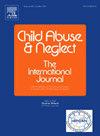Neighborhood collective efficacy reduces child maltreatment through decreasing parenting stress: A longitudinal path model
IF 3.4
2区 心理学
Q1 FAMILY STUDIES
引用次数: 0
Abstract
Background
Neighborhoods and families are crucial contexts for child maltreatment, yet research into mechanisms of neighborhood effects on child maltreatment remains limited.
Objective
This study examined longitudinal associations between neighborhood collective efficacy, maternal parenting stress, and child maltreatment.
Participants and setting
The study drew data from the Future of Families and Child Wellbeing Study (FFCWS). Participants included 2890 mothers who were interviewed when their children were born and at ages 3, 5, 9, and 15.
Methods
A longitudinal path model was utilized to analyze direct and indirect effects of neighborhood collective efficacy on child maltreatment via parenting stress.
Results
Neighborhood collective efficacy and parenting stress demonstrated temporal stability over time (ages 3 to 15). Child maltreatment had carry-over effects during childhood (ages 3 to 9) but not into adolescence (age 15). Higher parenting stress in earlier years was associated with increased child maltreatment in childhood (ages 3 to 9), but not in adolescence (age 15). Neighborhood collective efficacy was associated with reduced parenting stress over time. In early childhood (ages 3 to 9), neighborhood collective efficacy protected against child maltreatment through larger direct effects than indirect effects via reduced parenting stress. In later years (ages 5 to 15), however, neighborhood collective efficacy had neither direct nor indirect effects on childhood maltreatment.
Conclusions
Findings highlight early, targeted prevention and intervention strategies for child maltreatment. Programs aimed at reducing parenting stress, increasing community-based child protection practices, and strengthening neighborhood closeness could mitigate child maltreatment.
邻里集体效能通过降低父母压力来减少儿童虐待:一个纵向路径模型。
背景:社区和家庭是儿童虐待的重要背景,但社区对儿童虐待的影响机制的研究仍然有限。目的:探讨邻里集体效能、母亲教养压力与儿童虐待之间的纵向关系。参与者和环境:该研究的数据来自家庭和儿童福利的未来研究(FFCWS)。参与者包括2890名母亲,她们在孩子出生时以及3岁、5岁、9岁和15岁时接受了采访。方法:采用纵向路径模型分析邻里集体效能对父母压力对儿童虐待的直接和间接影响。结果:邻里集体效能和父母压力表现出时间稳定性(3 ~ 15岁)。儿童虐待在儿童期(3至9岁)有结转效应,但不会进入青春期(15岁)。早期较高的父母压力与儿童时期(3至9岁)虐待增加有关,但与青春期(15岁)无关。随着时间的推移,邻里集体效能与父母压力的减少有关。在幼儿期(3至9岁),邻里集体效能通过减少养育压力的直接效应大于间接效应,保护儿童免受虐待。然而,在以后的岁月里(5至15岁),邻里集体效能对儿童虐待既没有直接影响,也没有间接影响。结论:研究结果强调了儿童虐待的早期、有针对性的预防和干预策略。旨在减轻父母压力、增加社区儿童保护实践和加强邻里关系的项目可以减少儿童虐待。
本文章由计算机程序翻译,如有差异,请以英文原文为准。
求助全文
约1分钟内获得全文
求助全文
来源期刊

Child Abuse & Neglect
Multiple-
CiteScore
7.40
自引率
10.40%
发文量
397
期刊介绍:
Official Publication of the International Society for Prevention of Child Abuse and Neglect. Child Abuse & Neglect The International Journal, provides an international, multidisciplinary forum on all aspects of child abuse and neglect, with special emphasis on prevention and treatment; the scope extends further to all those aspects of life which either favor or hinder child development. While contributions will primarily be from the fields of psychology, psychiatry, social work, medicine, nursing, law enforcement, legislature, education, and anthropology, the Journal encourages the concerned lay individual and child-oriented advocate organizations to contribute.
 求助内容:
求助内容: 应助结果提醒方式:
应助结果提醒方式:


